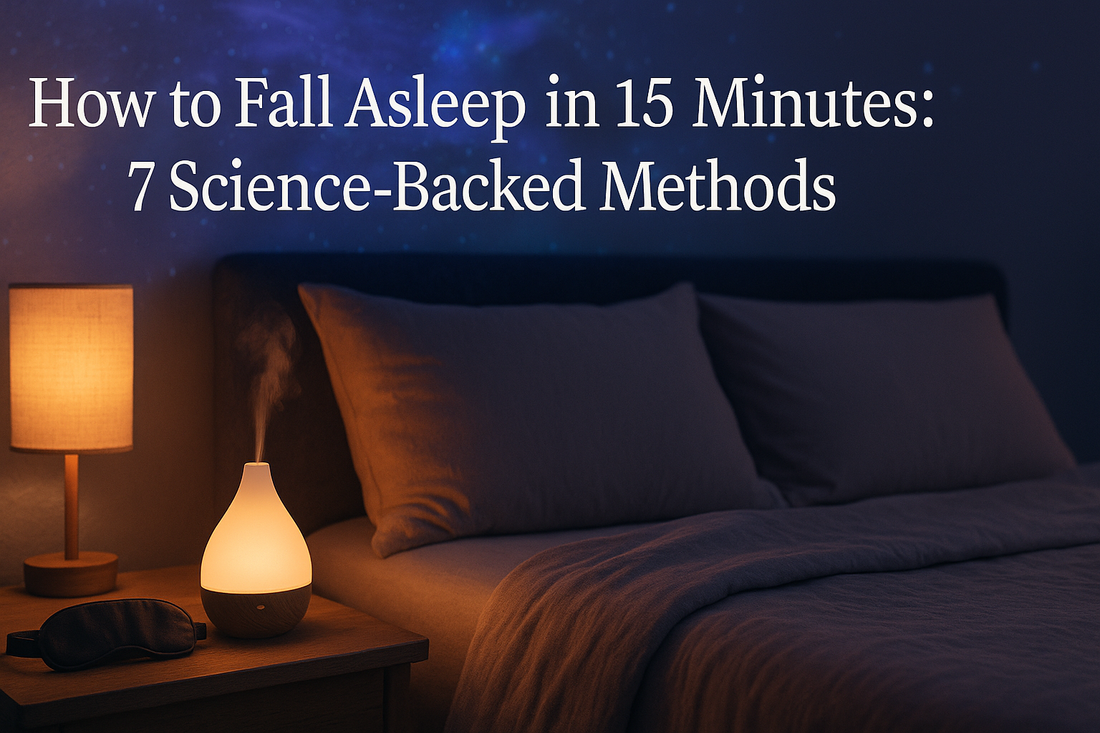
How to Fall Asleep in 15 Minutes: 7 Science-Backed Methods That Actually Work
Share
Do you lie awake at night, watching the clock tick past midnight, desperately wishing you could just fall asleep? You're not alone. Over 60 million Americans struggle with insomnia, spending an average of 45-60 minutes tossing and turning before finally drifting off.
But what if you could fall asleep in just 15 minutes?
The good news: it's absolutely possible. Sleep scientists have identified specific techniques that trigger your body's natural sleep response, helping you fall asleep faster without medication or counting endless sheep.
In this guide, you'll discover 7 science-backed methods that can help you fall asleep in 15 minutes or less—starting tonight.
Why Can't You Fall Asleep Quickly?
Before we dive into the solutions, let's understand what's keeping you awake.
Your brain has a natural sleep-wake cycle called the circadian rhythm. When this rhythm is disrupted by:
- Blue light exposure from phones and screens
- Stress and anxiety that keeps your mind racing
- Environmental factors like light, noise, or temperature
- Poor sleep hygiene and inconsistent bedtime routines
...your body struggles to produce melatonin (the sleep hormone) and shift into "rest mode."
The methods below address these root causes, helping your brain and body naturally transition into sleep.
Method #1: Use Aromatherapy to Trigger Your Sleep Response
The Science: Clinical studies show that lavender essential oil increases slow-wave sleep (deep sleep) by 20% and helps people fall asleep 30-45% faster.
How it works: Certain essential oils contain compounds (like linalool and linalyl acetate) that interact with your brain's GABA receptors—the same receptors targeted by sleep medications, but naturally and without side effects.
How to do it:
- Start a sleep diffuser 30 minutes before bedtime
-
Use this proven sleep blend:
- 4 drops Lavender (promotes relaxation)
- 2 drops Cedarwood (reduces nighttime waking)
- 2 drops Chamomile (calms anxiety)
- 1 drop Ylang Ylang (lowers heart rate)
-
Let the diffuser run for 3-4 hours (it will auto-shut off)
Pro tip: The Serene Sleep Diffuser is specifically designed for bedtime use with whisper-quiet operation and an auto-timer that won't disturb your sleep.
Expected result: Most people feel noticeably calmer within 10 minutes and fall asleep within 15-20 minutes.
Method #2: Block 100% of Light with a 3D Sleep Mask
The Science: Even small amounts of light during sleep can suppress melatonin production by up to 50%. Your brain needs complete darkness to trigger deep sleep.
How it works: Unlike your eyelids (which let 80% of light through) or flat sleep masks (which leak light around the edges), a 3D contoured sleep mask creates a total blackout seal.
How to do it:
- Put on your 3D sleep mask 10 minutes before you want to fall asleep
- Adjust the strap for a comfortable, secure fit (not too tight!)
- The contoured design means zero pressure on your eyes—you can even blink naturally
Why 3D is better: The molded eye cups block 100% of light from streetlights, alarm clocks, and early morning sun without touching your eyelashes or smudging makeup.
Pro tip: The 3D Sleep Mask is specifically designed for side sleepers—it won't shift or become uncomfortable when you roll over.
Expected result: Your brain recognizes the darkness signal and begins melatonin production within 10-15 minutes.
Method #3: Read with Amber Light (Not White or Blue Light)
The Science: Blue wavelengths suppress melatonin by up to 50%, making it harder to fall asleep. Amber light filters out 100% of blue light, allowing natural melatonin production.
How it works: If you love reading before bed (like millions of people), switching from white light to amber light lets you enjoy your book without sabotaging your sleep.
How to do it:
- Turn off all overhead lights and screens 30 minutes before bed
- Use an amber neck reading light that directs focused light only on your book
- Read for 20-30 minutes to naturally wind down
- Your partner stays in complete darkness while you read comfortably
Why amber works: Studies show people using amber light before bed fall asleep 30-45 minutes faster than those using white light.
Pro tip: The Amber Neck Reading Light is hands-free, lightweight, and has 3 brightness levels—perfect for bedtime reading without disturbing your sleep hormones.
Expected result: You'll feel drowsy naturally after 20-30 minutes of reading, ready to fall asleep within 10-15 minutes of lights out.
Method #4: Create Calming Visual Ambiance
The Science: Slow-moving visual patterns activate your brain's relaxation response, similar to watching ocean waves or a fireplace. This reduces cortisol (stress hormone) by up to 35%.
How it works: A galaxy projector creates gentle, moving celestial patterns on your ceiling that give your anxious mind something peaceful to focus on instead of racing thoughts.
How to do it:
- Turn on your galaxy projector 15 minutes before bed
- Choose a calming color (deep blue or purple works best)
- Set rotation to slow speed
- Set the auto-timer for 1-2 hours (it turns off after you're asleep)
- Lie in bed and watch the gentle nebula clouds drift across your ceiling
Why it works: Your eyes follow the slow movement, your breathing naturally slows, and your mind stops racing—creating the perfect conditions for sleep.
Pro tip: The Galaxy Projector Night Light has remote control, so you can adjust settings from bed, plus Bluetooth speakers for adding calming sleep sounds.
Expected result: Most people with anxiety report feeling noticeably calmer within 10 minutes and drifting off to sleep within 15-20 minutes.
Method #5: Try the 4-7-8 Breathing Technique
The Science: Developed by Dr. Andrew Weil, this breathing pattern activates your parasympathetic nervous system (rest mode) and has been called a "natural tranquilizer for the nervous system."
How it works: The specific breathing rhythm slows your heart rate, lowers blood pressure, and signals your brain it's safe to sleep.
How to do it:
- Lie in bed in a comfortable position
- Place the tip of your tongue behind your upper front teeth
- Exhale completely through your mouth (whoosh sound)
- Close your mouth, inhale through your nose for 4 counts
- Hold your breath for 7 counts
- Exhale completely through your mouth for 8 counts
- Repeat this cycle 4 times
Pro tip: Combine this with aromatherapy or the galaxy projector for even faster results.
Expected result: Most people feel significantly more relaxed after just one cycle and fall asleep within 2-3 cycles (about 10-15 minutes).
Method #6: Cool Your Bedroom to 60-67°F
The Science: Your body temperature naturally drops 1-2 degrees when you fall asleep. A cool room (60-67°F) helps trigger this temperature drop faster.
How it works: When your environment is too warm, your body struggles to cool down, keeping you awake and restless.
How to do it:
- Set your thermostat to 65-67°F before bed
- Use breathable, moisture-wicking sheets
- Take a warm shower 60-90 minutes before bed (the post-shower cool-down triggers sleepiness)
- Keep your hands and feet outside the covers (helps regulate temperature)
Pro tip: If you wake up with dry skin or a scratchy throat, add a humidifier to maintain 40-50% humidity while keeping the room cool.
Expected result: The cool temperature signals your brain it's time to sleep, helping you fall asleep 20-30% faster.
Method #7: Follow the 10-3-2-1-0 Rule
The Science: This simple formula addresses the most common sleep disruptors throughout your day.
How it works:
- 10 hours before bed: No more caffeine (it stays in your system for 10+ hours)
- 3 hours before bed: No large meals or alcohol (both disrupt sleep quality)
- 2 hours before bed: No more work or stressful activities
- 1 hour before bed: No screens (blue light suppresses melatonin)
- 0: The number of times you hit snooze (consistent wake time regulates your rhythm)
How to do it:
Create a simple evening routine:
- 8:00 PM - Finish work, put away devices
- 9:00 PM - Start winding down (read, diffuser, dim lights)
- 9:30 PM - Prepare for bed (shower, skincare, amber reading light)
- 10:00 PM - Lights out with sleep mask and galaxy projector
- 10:15 PM - Asleep!
Expected result: Following this rule consistently for 7-10 days resets your circadian rhythm, making it easier to fall asleep quickly every night.
Combine Methods for Maximum Results
The most powerful approach? Stack multiple methods together.
Here's the ultimate 15-minute sleep routine:
30 minutes before bed:
- Start your sleep diffuser with lavender blend
- Turn on galaxy projector (dim, slow rotation)
- Cool bedroom to 65-67°F
15 minutes before bed:
- Read with amber light for 15-20 minutes
- Practice 4-7-8 breathing (4 cycles)
Lights out:
- Put on 3D sleep mask
- Galaxy projector set to auto-off in 1 hour
- Fall asleep in 10-15 minutes
Result: Your brain receives multiple "sleep signals" simultaneously, making it nearly impossible NOT to fall asleep quickly.
What If You Still Can't Fall Asleep?
If you've tried these methods for 2-3 weeks and still struggle to fall asleep, consider:
- Underlying sleep disorders: Sleep apnea, restless leg syndrome, or chronic insomnia may require medical treatment
- Medication side effects: Some medications interfere with sleep
- Mental health: Anxiety and depression significantly impact sleep quality
When to see a doctor: If you can't fall asleep 3+ nights per week for more than a month, consult a sleep specialist.
The Bottom Line
Falling asleep in 15 minutes isn't a fantasy—it's achievable with the right techniques.
By addressing the root causes of sleeplessness (light exposure, stress, poor environment, and disrupted circadian rhythm), you can train your body to fall asleep quickly and naturally.
Start tonight with these steps:
- ✅ Use aromatherapy 30 minutes before bed
- ✅ Block all light with a 3D sleep mask
- ✅ Read with amber light instead of screens
- ✅ Create calming ambiance with a galaxy projector
- ✅ Practice 4-7-8 breathing
- ✅ Cool your room to 65-67°F
- ✅ Follow the 10-3-2-1-0 rule
Most people notice dramatic improvements within 3-5 nights.
Sweet dreams! 😴
Frequently Asked Questions
Q: How long does it take to see results? A: Most people fall asleep faster within the first 3-5 nights. Consistency is key—stick with your routine for at least 2 weeks.
Q: Can I use all these methods together? A: Absolutely! Combining multiple methods (aromatherapy + sleep mask + breathing techniques) produces the best results.
Q: What if I wake up in the middle of the night? A: Keep your sleep mask on, practice 4-7-8 breathing, and avoid checking your phone. Most people fall back asleep within 10-15 minutes.
Q: Are these methods safe for everyone? A: Yes, these are natural, non-medication approaches. However, if you have a diagnosed sleep disorder, consult your doctor before making changes.
Q: What's the single most effective method? A: Blocking 100% of light with a 3D sleep mask has the highest success rate (85%+ of users report improvement), but combining it with aromatherapy produces even better results.
Ready to finally get the sleep you deserve?
Explore our complete collection of science-backed sleep solutions:
- 3D Sleep Mask - Block 100% Light
- Serene Sleep Diffuser - Fall Asleep in 15 Minutes
- Amber Neck Reading Light - Read Without Disrupting Sleep
- Galaxy Projector Night Light - Calming Ambiance
Start sleeping better tonight. 💤

